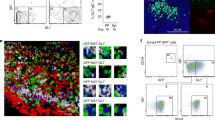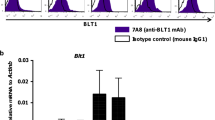Abstract
The mucosal immune system forms the largest part of the entire immune system, containing about three-quarters of all lymphocytes and producing grams of secretory IgA daily to protect the mucosal surface from pathogens1,2,3. To evoke the mucosal immune response, antigens on the mucosal surface must be transported across the epithelial barrier into organized lymphoid structures such as Peyer’s patches4. This function, called antigen transcytosis, is mediated by specialized epithelial M cells5,6. The molecular mechanisms promoting this antigen uptake, however, are largely unknown. Here we report that glycoprotein 2 (GP2), specifically expressed on the apical plasma membrane of M cells among enterocytes, serves as a transcytotic receptor for mucosal antigens. Recombinant GP2 protein selectively bound a subset of commensal and pathogenic enterobacteria, including Escherichia coli and Salmonella enterica serovar Typhimurium (S. Typhimurium), by recognizing FimH, a component of type I pili on the bacterial outer membrane. Consistently, these bacteria were colocalized with endogenous GP2 on the apical plasma membrane as well as in cytoplasmic vesicles in M cells. Moreover, deficiency of bacterial FimH or host GP2 led to defects in transcytosis of type-I-piliated bacteria through M cells, resulting in an attenuation of antigen-specific immune responses in Peyer’s patches. GP2 is therefore a previously unrecognized transcytotic receptor on M cells for type-I-piliated bacteria and is a prerequisite for the mucosal immune response to these bacteria. Given that M cells are considered a promising target for oral vaccination against various infectious diseases7,8, the GP2-dependent transcytotic pathway could provide a new target for the development of M-cell-targeted mucosal vaccines.
This is a preview of subscription content, access via your institution
Access options
Subscribe to this journal
Receive 51 print issues and online access
$199.00 per year
only $3.90 per issue
Buy this article
- Purchase on Springer Link
- Instant access to full article PDF
Prices may be subject to local taxes which are calculated during checkout




Similar content being viewed by others
References
Cerutti, A. & Rescigno, M. The biology of intestinal immunoglobulin A responses. Immunity 28, 740–750 (2008)
Fagarasan, S. et al. Critical roles of activation-induced cytidine deaminase in the homeostasis of gut flora. Science 298, 1424–1427 (2002)
Peterson, D. A., McNulty, N. P., Guruge, J. L. & Gordon, J. I. IgA response to symbiotic bacteria as a mediator of gut homeostasis. Cell Host Microbe 2, 328–339 (2007)
Craig, S. W. & Cebra, J. J. Peyer’s patches: an enriched source of precursors for IgA-producing immunocytes in the rabbit. J. Exp. Med. 134, 188–200 (1971)
Owen, R. L. & Jones, A. L. Epithelial cell specialization within human Peyer’s patches: an ultrastructural study of intestinal lymphoid follicles. Gastroenterology 66, 189–203 (1974)
Neutra, M. R., Mantis, N. J. & Kraehenbuhl, J. P. Collaboration of epithelial cells with organized mucosal lymphoid tissues. Nature Immunol. 2, 1004–1009 (2001)
Nochi, T. et al. A novel M cell-specific carbohydrate-targeted mucosal vaccine effectively induces antigen-specific immune responses. J. Exp. Med. 204, 2789–2796 (2007)
Sirard, J. C., Niedergang, F. & Kraehenbuhl, J. P. Live attenuated Salmonella: a paradigm of mucosal vaccines. Immunol. Rev. 171, 5–26 (1999)
Sansonetti, P. J. & Phalipon, A. M cells as ports of entry for enteroinvasive pathogens: mechanisms of interaction, consequences for the disease process. Semin. Immunol. 11, 193–203 (1999)
Kraehenbuhl, J. P. & Neutra, M. R. Epithelial M cells: differentiation and function. Annu. Rev. Cell Dev. Biol. 16, 301–332 (2000)
Hase, K. et al. Distinct gene expression profiles characterize cellular phenotypes of follicle-associated epithelium and M cells. DNA Res. 12, 127–137 (2005)
Terahara, K. et al. Comprehensive gene expression profiling of Peyer’s patch M cells, villous M-like cells, and intestinal epithelial cells. J. Immunol. 180, 7840–7846 (2008)
Hoops, T. C. & Rindler, M. J. Isolation of the cDNA encoding glycoprotein-2 (GP-2), the major zymogen granule membrane protein. Homology to uromodulin/Tamm–Horsfall protein. J. Biol. Chem. 266, 4257–4263 (1991)
Verbrugghe, P., Kujala, P., Waelput, W., Peters, P. J. & Cuvelier, C. A. Clusterin in human gut-associated lymphoid tissue, tonsils, and adenoids: localization to M cells and follicular dendritic cells. Histochem. Cell Biol. 129, 311–320 (2008)
Fukuoka, S., Freedman, S. D., Yu, H., Sukhatme, V. P. & Scheele, G. A. GP-2/THP gene family encodes self-binding glycosylphosphatidylinositol-anchored proteins in apical secretory compartments of pancreas and kidney. Proc. Natl Acad. Sci. USA 89, 1189–1193 (1992)
Mo, L. et al. Ablation of the Tamm–Horsfall protein gene increases susceptibility of mice to bladder colonization by type 1-fimbriated Escherichia coli. Am. J. Physiol. Renal Physiol. 286, F795–F802 (2004)
Pizarro-Cerda, J. & Cossart, P. Bacterial adhesion and entry into host cells. Cell 124, 715–727 (2006)
Yu, S. & Lowe, A. W. The pancreatic zymogen granule membrane protein, GP2, binds Escherichia coli type 1 fimbriae. BMC Gastroenterol. 9, 58 (2009)
Ewen, S. W. et al. Salmonella enterica var Typhimurium and Salmonella enterica var Enteritidis express type 1 fimbriae in the rat in vivo. FEMS Immunol. Med. Microbiol. 18, 185–192 (1997)
McDonald, D. et al. Recruitment of HIV and its receptors to dendritic cell–T cell junctions. Science 300, 1295–1297 (2003)
Tanaka, Y. et al. T helper type 2 differentiation and intracellular trafficking of the interleukin 4 receptor-α subunit controlled by the Rac activator Dock2. Nature Immunol. 8, 1067–1075 (2007)
Clark, M. A., Hirst, B. H. & Jepson, M. A. M-cell surface β1 integrin expression and invasin-mediated targeting of Yersinia pseudotuberculosis to mouse Peyer’s patch M cells. Infect. Immun. 66, 1237–1243 (1998)
Iwasaki, A. & Kelsall, B. L. Localization of distinct Peyer’s patch dendritic cell subsets and their recruitment by chemokines macrophage inflammatory protein (MIP)-3α, MIP-3β, and secondary lymphoid organ chemokine. J. Exp. Med. 191, 1381–1394 (2000)
VanCott, J. L. et al. Regulation of mucosal and systemic antibody responses by T helper cell subsets, macrophages, and derived cytokines following oral immunization with live recombinant Salmonella. J. Immunol. 156, 1504–1514 (1996)
Martinoli, C., Chiavelli, A. & Rescigno, M. Entry route of Salmonella typhimurium directs the type of induced immune response. Immunity 27, 975–984 (2007)
Hashizume, T. et al. Peyer’s patches are required for intestinal immunoglobulin A responses to Salmonella spp. Infect. Immun. 76, 927–934 (2008)
Rindler, M. J. & Hoops, T. C. The pancreatic membrane protein GP-2 localizes specifically to secretory granules and is shed into the pancreatic juice as a protein aggregate. Eur. J. Cell Biol. 53, 154–163 (1990)
Kobayashi, K., Yanagihara, K., Ishiguro, K. & Fukuoka, S. GP2/THP gene family of self-binding, GPI-anchored proteins forms a cluster at chromosome 7F1 region in mouse genome. Biochem. Biophys. Res. Commun. 322, 659–664 (2004)
Yu, S., Michie, S. A. & Lowe, A. W. Absence of the major zymogen granule membrane protein, GP2, does not affect pancreatic morphology or secretion. J. Biol. Chem. 279, 50274–50279 (2004)
Greisen, K., Loeffelholz, M., Purohit, A. & Leong, D. PCR primers and probes for the 16S rRNA gene of most species of pathogenic bacteria, including bacteria found in cerebrospinal fluid. J. Clin. Microbiol. 32, 335–351 (1994)
Hase, K. et al. The membrane-bound chemokine CXCL16 expressed on follicle-associated epithelium and M cells mediates lympho-epithelial interaction in GALT. J. Immunol. 176, 43–51 (2006)
Waguri, S. & Komatsu, M. Biochemical and morphological detection of inclusion bodies in autophagy-deficient mice. Methods Enzymol. 453, 181–196 (2009)
Hopkins, S. A., Niedergang, F., Corthesy-Theulaz, I. E. & Kraehenbuhl, J. P. A recombinant Salmonella typhimurium vaccine strain is taken up and survives within murine Peyer’s patch dendritic cells. Cell. Microbiol. 2, 59–68 (2000)
Herring, C. D., Glasner, J. D. & Blattner, F. R. Gene replacement without selection: regulated suppression of amber mutations in Escherichia coli. Gene 311, 153–163 (2003)
Datsenko, K. A. & Wanner, B. L. One-step inactivation of chromosomal genes in Escherichia coli K-12 using PCR products. Proc. Natl Acad. Sci. USA 97, 6640–6645 (2000)
Jackson, R. J. et al. Optimizing oral vaccines: induction of systemic and mucosal B-cell and antibody responses to tetanus toxoid by use of cholera toxin as an adjuvant. Infect. Immun. 61, 4272–4279 (1993)
Yamamoto, M. et al. Alternate mucosal immune system: organized Peyer’s patches are not required for IgA responses in the gastrointestinal tract. J. Immunol. 164, 5184–5191 (2000)
Gulig, P. A., Doyle, T. J., Hughes, J. A. & Matsui, H. Analysis of host cells associated with the Spv-mediated increased intracellular growth rate of Salmonella typhimurium in mice. Infect. Immun. 66, 2471–2485 (1998)
Carter, P. B. & Collins, F. M. Experimental Yersinia enterocolitica infection in mice: kinetics of growth. Infect. Immun. 9, 851–857 (1974)
Acknowledgements
We thank K. Kanno and A. Yamada for help in immunoelectron microscopy; Y. Yamada for secretarial assistance; M. Ohmae for technical assistance; H. Watarai for pertinent advice and discussion; P. D. Burrows, T. Takemori, S. Yamasaki and H. Kitamura for critical review of the manuscript; and the National BioResource Project (NIG, Japan) for E. coli (the Keio collection). This study was supported in part by Grants-in-Aid for Young Scientists (B) (K.H.), Scientific research (B) (H.O.), Scientific Research in Priority Areas (H.O. and K.H.), and Scientific Research on Innovative Areas (H.O.) from the Ministry of Education, Culture, Sports, Science and Technology of Japan, the Takeda Science Foundation (K.H.), and NIH awards DK56339 and DK43294 (A.W.L.).
Author Contributions K. Hase and K. Kawano designed and performed the experiments, analysed the data and wrote the manuscript. T.N., G.S.P., S.F., M.E., K. Kadokura, Y.F., S. Kawano, A.Y., G.N., S. Kimura, M.I., K. Hamura, S.W. and H.K. contributed to the experimental work, and T.M. helped in data analysis. T.T. developed the FimH-deficient strain of rSalmonella-ToxC. K.I. prepared bacteria. S-I.F. and A.W.L. provided GP2-deficient mice. H.O. supervised the project and made significant contributions to the manuscript.
Author information
Authors and Affiliations
Corresponding author
Supplementary information
Supplementary Information
This file contains Supplementary Figures 1-12 with Legends and Legends for Supplementary Movies 1-4. (PDF 2084 kb)
Supplementary Movie 1
This movie shows a three-dimensional image of M cells taking up anti-mouse GP2 mAb in the ligated intestinal loop assay (see file s1 for full Legend). (MPG 1908 kb)
Supplementary Movie 2
The movie shows the visualization of an M cell taking up E. coli (see file s1 for full Legend). (MPG 1771 kb)
Supplementary Movie 3
This movie shows the transcytosis of S. Typhimurium by an M cell (see file s1 for full Legend). (MPG 974 kb)
Supplementary Movie 4
This movie shows the transport of E. coli from an M cell to underlying DC (see file s1 for full Legend). (MPG 494 kb)
Rights and permissions
About this article
Cite this article
Hase, K., Kawano, K., Nochi, T. et al. Uptake through glycoprotein 2 of FimH+ bacteria by M cells initiates mucosal immune response. Nature 462, 226–230 (2009). https://doi.org/10.1038/nature08529
Received:
Accepted:
Issue Date:
DOI: https://doi.org/10.1038/nature08529
This article is cited by
-
Glycoprotein 2 as a gut gate keeper for mucosal equilibrium between inflammation and immunity
Seminars in Immunopathology (2024)
-
Cracking the intestinal lymphatic system window utilizing oral delivery vehicles for precise therapy
Journal of Nanobiotechnology (2023)
-
Intestinal Peyer’s Patches: Structure, Function, and In Vitro Modeling
Tissue Engineering and Regenerative Medicine (2023)
-
Current Progress and Challenges in the Study of Adjuvants for Oral Vaccines
BioDrugs (2023)
-
Gut microbiota alternation under the intestinal epithelium-specific knockout of mouse Piga gene
Scientific Reports (2022)
Comments
By submitting a comment you agree to abide by our Terms and Community Guidelines. If you find something abusive or that does not comply with our terms or guidelines please flag it as inappropriate.



